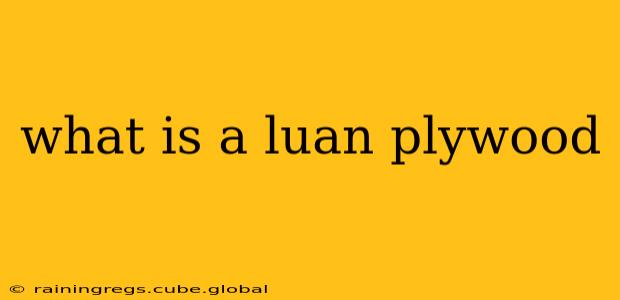Luan plywood, often simply called "luan," is a type of hardwood plywood primarily sourced from the Lauan tree (genus Shorea), found throughout Southeast Asia. It's known for its affordability and lightweight nature, making it a popular choice for various applications, particularly in the construction and furniture industries. But what exactly makes it unique, and what are its strengths and weaknesses? Let's dive in.
What kind of wood is Luan plywood made from?
Luan plywood is manufactured from various species of the Shorea genus, often referred to as Lauan or Philippine mahogany. While the term "mahogany" is used, it's crucial to understand that it's not true mahogany, which comes from a completely different family of trees. The specific species used can vary depending on availability and the manufacturer, leading to some slight variations in properties.
Is Luan plywood strong?
Luan plywood's strength is moderate. It's not as strong as hardwood plywoods like oak or maple, but it's considerably stronger and more stable than softwood plywoods such as pine. Its strength is adequate for many applications, but it's not suitable for projects requiring exceptional durability or heavy load-bearing capacity.
What are the uses of Luan plywood?
Due to its lightweight nature, relatively low cost, and acceptable strength, Luan plywood finds its way into a wide range of applications:
- Furniture: Often used for cabinet backs, drawers, and less-stressed parts of furniture pieces. Its affordability makes it a cost-effective choice for mass-produced furniture.
- Construction: Suitable for subflooring, sheathing, and underlayment in certain applications. Its light weight makes it easier to handle on construction sites.
- Craft projects: A popular choice for hobbyists and DIY enthusiasts due to its ease of cutting and shaping.
- Soundproofing: Luan's density can contribute to sound dampening, making it suitable for soundproofing projects, although more specialized materials might be preferred for higher performance.
What are the disadvantages of Luan plywood?
While Luan offers several advantages, it's important to be aware of its drawbacks:
- Susceptibility to moisture: Luan is more prone to damage from moisture than other hardwood plywoods. Exposure to excessive humidity or water can lead to warping, swelling, and delamination. Proper sealing and protection are essential.
- Not suitable for all applications: Its moderate strength limits its use in applications requiring high load-bearing capacity or significant durability.
- Appearance: The grain and color can be inconsistent, and it may not offer the aesthetic appeal of more expensive hardwoods.
Is Luan plywood good for outdoor use?
No, Luan plywood is generally not recommended for outdoor use. Its vulnerability to moisture makes it unsuitable for applications exposed to the elements. The plywood will likely warp, rot, and deteriorate quickly under such conditions. For outdoor projects, consider using exterior-grade plywood specifically designed for weathering.
Is Luan plywood better than other plywood?
Whether Luan plywood is "better" depends entirely on the intended application. It's an excellent choice for its price point when strength isn't the primary concern. However, for applications demanding high durability, strength, and moisture resistance, other hardwood plywoods may be more appropriate. For example, marine-grade plywood is much more resistant to water damage.
How can I identify Luan plywood?
Identifying Luan can be tricky as its appearance varies. Look for a relatively light-colored plywood with a fine to medium grain. However, the most reliable way to confirm is to check the manufacturer's label or documentation, which should clearly specify the wood species.
This comprehensive guide provides a detailed overview of Luan plywood, highlighting its properties, uses, and limitations. Remember to choose the right plywood for your specific needs, considering factors like strength, durability, and cost-effectiveness.
